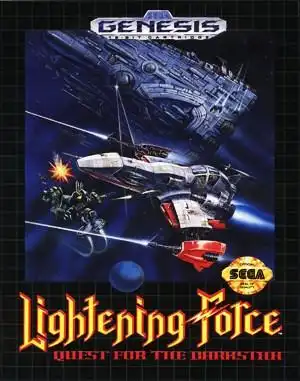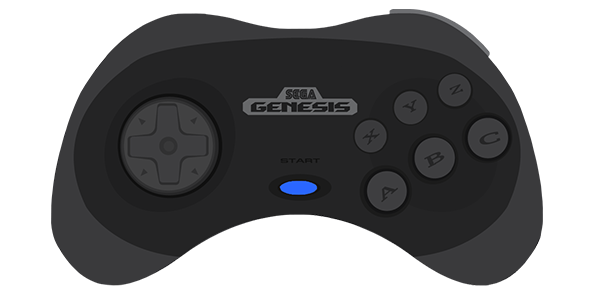Lightening Force: Quest for the Darkstar - A Genesis Shmup Legend Revisited
Few games defined the raw power and attitude of the Sega Genesis like its premier shoot 'em ups. Among the pantheon of pixelated projectiles and relentless alien hordes, one title stands particularly tall, albeit with a slightly confusing identity crisis depending on where you lived: Lightening Force: Quest for the Darkstar. Known to our friends across the pond as Thunder Force IV, this Technosoft masterpiece pushed the 16-bit hardware to its absolute limits, delivering an experience that was as breathtaking as it was brutal.
If you owned a Genesis in the early 90s and craved fast-paced, side-scrolling action, chances are Lightening Force left an indelible mark. It wasn't just another shmup; it felt like a statement. But does this quest for the Darkstar still hold up today, or is it merely a relic of rose-tinted nostalgia? Let's power up and find out.
The Genesis Era Shmup King? Its Reputation Then and Now
Released in 1992 (Japan) and 1993 (North America/Europe), Lightening Force arrived when the 16-bit war was in full swing. Technosoft, already veterans of the Thunder Force series, pulled out all the stops. Critics at the time widely hailed it as one of the best shooters on the platform, praising its technical prowess and intense action.
It built upon the foundation of Thunder Force III, bringing back fan-favorite features like adjustable ship speed and a limited stage select for the initial levels. But Lightening Force felt bigger, bolder, and more ambitious in almost every way. For many Genesis fans, it wasn't just a great shmup; it was the great shmup.
Blasting Off: Gameplay & Mechanics That Hooked Us
At its core, Lightening Force is a horizontal shoot 'em up. You pilot the STYX fighter, weaving through enemy formations and dodging screen-filling boss attacks. But several elements made it stand out:
- Adjustable Speed: A simple yet crucial feature. You could instantly toggle your ship's speed, allowing for precise navigation through tight spots or quick dashes across open areas.
- Deep Weapon System: Forget picking up temporary power-ups. Lightening Force gave you a suite of permanent, swappable weapons once acquired. From the classic Twin Shot and Back Shot to the seeking Hunter and the powerful Blade, you had options. Losing a life meant losing your current weapon, adding serious stakes.
- The CLAW & Thunder Blade: A signature of the series, the CLAW satellites provided extra firepower and defense. Collecting two allowed access to the devastating, chargeable Thunder Blade attack, a screen-clearing beam that felt incredibly satisfying to unleash.
- Vertical Exploration: While primarily horizontal, stages often had significant vertical space. You weren't just stuck on one plane; you could fly up or down to find hidden items, avoid certain enemy waves, or gain tactical advantages. This added a layer of exploration unusual for the genre at the time.
A Visual & Audio Powerhouse
If Lightening Force is remembered for anything beyond its difficulty, it's how it looked and sounded. Technosoft squeezed every ounce of performance from the Genesis:
- Graphics: Multi-layer parallax scrolling created incredible depth, making stages feel vast and alive. Foreground elements added to the sense of speed. Sprites were large and detailed, from standard enemies to the massive, multi-jointed bosses that filled the screen. It genuinely looked like one of the best games on the system.
- Soundtrack: The FM synthesis soundtrack is legendary. Composed by the Technosoft sound team, it delivered a high-energy, heavy metal-inspired score that perfectly matched the on-screen chaos. Tracks like "Omen" and "Fighting Spirit" are iconic among retro gamers.
The Dark Side: Difficulty & Design Quirks
Let's be honest: Lightening Force is hard. Like, controller-throwing, scream-at-the-screen hard. While some difficulty came from genuinely challenging design, some felt... less fair.
- Difficulty Spikes: The initial four stages, while tough, are manageable. Once you hit stage 5 onwards, the game ramps up dramatically. Enemies become denser, faster, and their bullet patterns more intricate and sometimes visually camouflaged against busy backgrounds.
- Bullet Sponge Bosses: While visually impressive, many bosses felt like they took an eternity to defeat. Their high health pools could make encounters feel tedious rather than exciting, especially if you lost your powered-up weapons.
- Slowdown: The price of those amazing graphics was performance dips. When the action got truly intense, the frame rate could chug significantly. While sometimes helpful for navigating dense bullet patterns, it could also feel jarring and lead to cheap hits.
- Off-Screen Threats: Enemies sometimes spawned right on top of or just behind your ship, which felt like a frustrating design choice intended to punish rather than challenge skill.
Playing Today: Emulation & Re-releases
Thankfully, experiencing Lightening Force: Quest for the Darkstar isn't limited to finding original Genesis hardware (though that's always the dream!).
- Sega Ages on Nintendo Switch: Sega re-released Thunder Force IV (including the Lightening Force version) as part of their Sega Ages line on the Switch. This version is highly recommended, featuring improvements from the Saturn port, save states, replays, online leaderboards, and the option to play the easier Saturn mode or even unlock the Thunder Force III ship, SYD.
- Emulation: For PC gamers, emulators like Kega Fusion or Genesis Plus GX (within RetroArch) allow you to play the original ROM. Websites like Archive.org sometimes host playable versions, though performance can vary. Ensure you own a legal copy of the game if using ROMs.
Is It Still Worth Playing?
Absolutely. While its difficulty can feel dated at times, and the slowdown is a technical flaw, Lightening Force: Quest for the Darkstar remains a landmark title in the shmup genre and a highlight of the Genesis library.
Its incredible presentation, fantastic soundtrack, and deep weapon system still provide a thrilling challenge. Playing it today, especially via the excellent Sega Ages port with its quality-of-life features, allows you to appreciate its strengths without some of the original hardware's frustrations. It's a high-octane trip back to the 90s that any retro shooter fan should take.
FAQ
Q: Is Lightening Force the same game as Thunder Force IV? A: Yes! Lightening Force: Quest for the Darkstar is the North American title for Thunder Force IV on the Sega Genesis/Mega Drive.
Q: Is Lightening Force a difficult game? A: Yes, it is widely considered a very difficult shmup, known for intense action, challenging bosses, and significant difficulty spikes later in the game.
Q: Where can I play Lightening Force today? A: You can play it on original Sega Genesis/Mega Drive hardware, via emulation (ensure legality), or through the Sega Ages release of Thunder Force IV on the Nintendo Switch.
Q: What are the best features of Lightening Force? A: It's praised for its stunning graphics (multi-layer scrolling, large sprites), legendary heavy metal-inspired soundtrack, deep weapon system, and adjustable ship speed.


